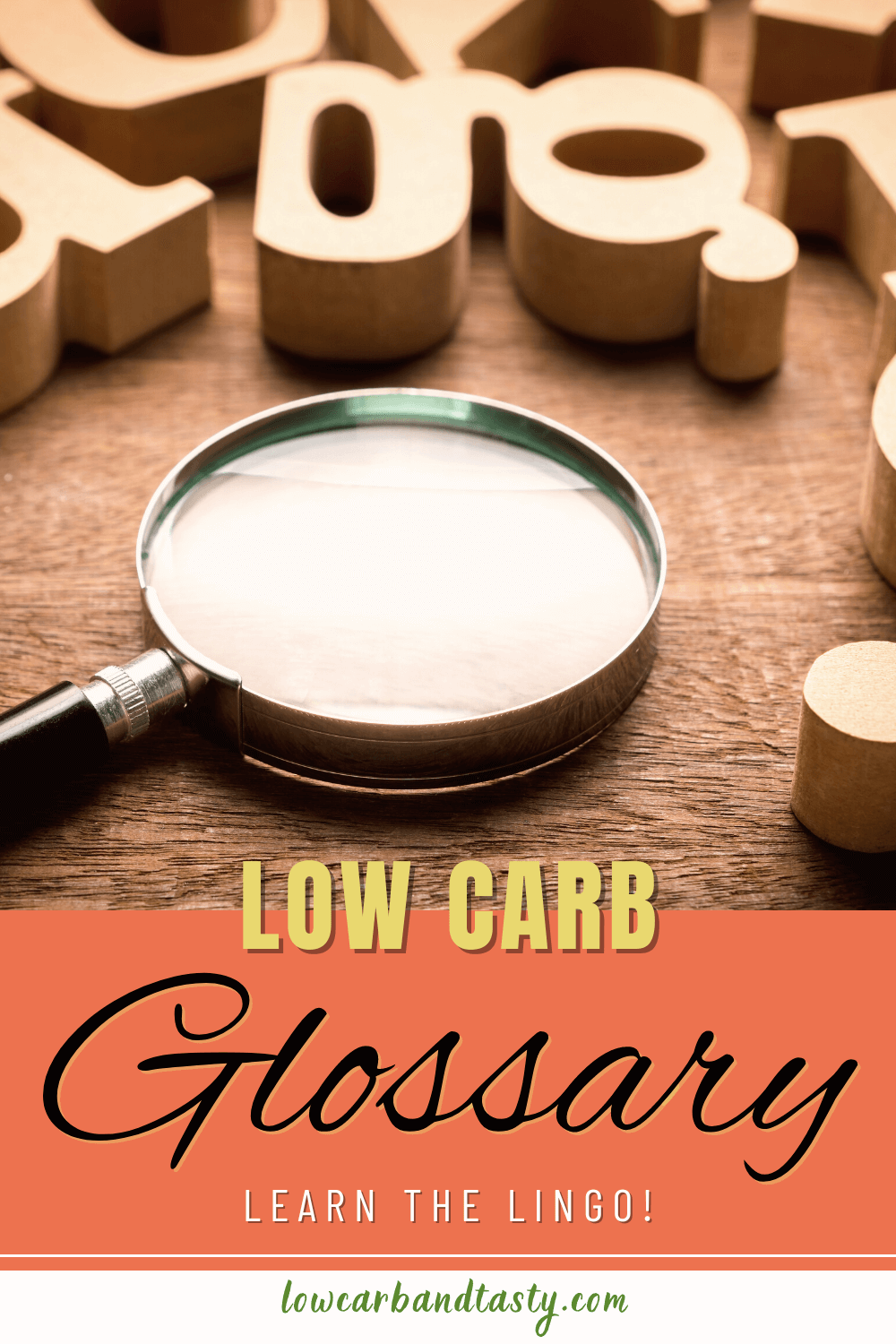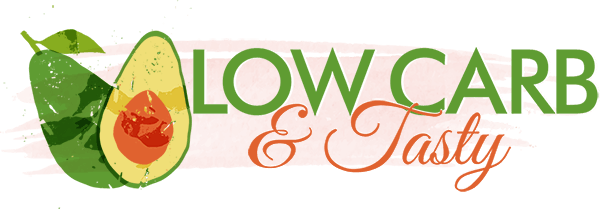What the heck is Fathead Dough? What are Chaffles? How are Net Carbs different than regular carbs? More and more people are discovering the many benefits of reducing their carb intake, but learning the lingo can feel like learning a new language! That’s where this Low Carb Glossary comes in.
Below you’ll find definitions to terms and phrases commonly found in the low carb space. Scroll through or click a letter below to jump to the corresponding entries!
A B C D E F G H I J K L M
N O P Q R S T U V W X Y Z
A
Atkins: A high-protein, high-fat, low carbohydrate diet popularized by Dr. Robert C. Atkins. Learn more about the Atkin’s diet on their official website.
B
Banting Diet: Another term for a low-carb, high-fat diet. Named for William Banting, who popularized the diet in the 1800s.
BHB (beta-hydroxybutyrate): A ketone produced by the body either through fasting or a high fat low carb diet.
Bio-Individuality: Each person has a unique body that reacts to food and exercise differently. Differences in anatomy, metabolism, body composition, and cell structure make a one-size-fits-all diet impossible.
BMI (Body Mass Index): Calculated by dividing your weight in kilograms by your height in meters and then squaring it.
BMR (Basal Metabolic Rate) / RMR (Resting Metabolic Rate): Used interchangeably, the minimum amount of energy your body needs to perform its most basic functions.
Bulletproof Coffee: Coffee with MCT oil or grass fed butter.
C
Carnivore: A diet consisting of animal products only. Also known as a zero carb diet.
Celiac Disease: A chronic immune disorder triggered by consuming gluten. It leads to damage of the intestinal lining and may cause diarrhea, fatigue, weight loss, bloating and anemia.
Chaffles: A low carb waffle made with cheese and other ingredients. The basic recipe is two eggs and one cup of shredded mozzarella cheese. Chaffles can be sweet or savory based on the ingredients used. Click here for my Garlic Bread Chaffle recipe.
CKD (Cyclic Ketogenic Diet): A diet in which you alternate days of low carb dieting with days of high-carb consumption.
Clean Keto: A ketogenic diet consisting of only unprocessed whole foods
Coconut Butter: A paste made from the flesh of the coconut meat. Usually has a strong coconut flavor.
Coconut Oil: Oil extracted from the coconut. Usually has a mild coconut flavor.
Collagen: A structural protein found in the body that repairs connective tissue. Collagen supplements are though to support anti-aging, as our bodies produce less collagen as we get older.
D
Dirty Keto: A version of the ketogenic diet where you can eat whatever you wish (including processed foods) as long as you stay within your macros.
E
Egg Fast: A type of fasting which allows only eggs and egg products.
Electrolytes: Electrically charged minerals in the body that are essential to body function.
Erythritol: A sugar alcohol used as a low carb sweetener.
Exogenous Ketones: Ketones that are consumed as a supplement rather than made by the body.
F
Fat-Adapted: The state that occurs when your body has completely transitioned from burning carbs for energy to burning fat (ketones) for energy. Usually achieved in 4-6 weeks of being in constant ketosis.
Fat Bomb: Foods that contain mostly fat.
Fathead Dough: A versatile dough typically made with almond or coconut flour, mozzarella cheese, and eggs.
Fiber: An indigestible carbohydrate. Soluble fiber dissolves in water to form a gel-like substance, while insoluble fiber doesn’t dissolve in water.
G
GI (Glycemic Index): The measurement of how fast a specific food item causes a person’s blood sugar level to rise. High glycemic foods induce blood sugar spikes, which cause the body to produce more insulin.
Glycogen: A substance deposited into bodily tissues as storage of carbohydrates. Glycogen turns into glucose when adding water.
Glucagon: A hormone produced by the pancreas. Glucagon triggers the conversion of glycogen back into glucose for energy. It works with insulin to regulate the body’s blood glucose levels.
Gluconeogenisis: The process of producing glucose from other sources, like protein or fat. An important process for maintaining blood sugar levels on a keto diet and essential for those with diabetes.
Glucose (Blood Sugar): A simple sugar obtained from food. Also referred to as blood sugar as it circulates in the blood.
GKI (Glucose Ketone Index): The calculation of glucose and ketone levels that provides an indication of overall metabolic health:
- 1-3: therapeutic level of ketosis and used to treat diseases such as cancer and Alzheimer’s
- 3-6: moderate level good for those with metabolic issues such as diabetes or obesity
- 6-9: ideal for weight loss and health maintenance
- > 9: the body is not in ketosis.
Gluten: A protein found in wheat, rye and barley that can cause digestive problems. Those with Celiac disease or non-Celiac gluten sensitivity should avoid foods containing gluten.
Grass Fed: Foods that are from an animal that has eaten a diet of mostly grass. Most animals today are fed grains or byproducts to fatten them up quickly (Grain Fed), which can affect the flavor and nutrient profile of the end product.
H
Heavy Whipping Cream (HWC): Used in recipes to provide creaminess and fat.
Himalayan Salt: A pink salt that is usually unprocessed and therefore has retained its minerals.
Hyperinsulinemia (HI): A state of chronic high levels of insulin.
I
IIFYM (If It Fits Your Macros): A flexible eating style focused on tracking macronutrients (macros) rather than calories.
Insulin: A hormone produced in the pancreas which helps transport glucose into cells. This process lowers blood sugar levels and converts glucose into glycogen or fat.
Insulin Resistance (IR): A condition where there has been a reduction in insulin’s effect on blood sugar. Ongoing intake of excessive carbohydrates leads to a corresponding flow of insulin responses which over time desensitizes receptors. These receptors can then no longer transport excess glucose, resulting in fat buildup which could cause Type 2 Diabetes.
Intermittent Fasting: An intentional period of not eating. There are several different methods including 16:8, 18:6, 5:2, and water fast.
Inulin: A prebiotic soluble fiber often used to sweeten keto foods.
K
Keto: Short for ketogenic. When carbohydrates are not present, the body converts fat to energy (called ketones). Ketosis occurs when ketones are the primary fuel source. Ketone levels can be measured with a urine stick, breath meter or ketone meter.
Keto Diet: A way of eating that restricts carbohydrate intake to less than 20g per day.
Keto Flu: A set of symptoms that may occur while adjusting to a low carb or keto diet. Symptoms differ for each person, but may include headaches, fatigue, cramps, or insomnia. Excess fluid released by the liver when starting a Keto diet also releases electrolytes. Increasing electrolyte consumption can prevent these symptoms.
Ketoacidosis: A medical condition that occurs when glucose in the blood is extremely low and ketones are extremely high. It can be fatal if not treated immediately. Almost exclusively found in those with type 1 diabetes.
Ketones: When carbohydrates are not present, fat is broken down into ketones to be used for fuel.
Ketosis: A state in which the body burns fat. Ketones are produced when fat is broken down in the liver. Typically defined as having ketone levels greater than 0.4 mmol/liter.
L
Lazy Keto: Similar to Dirty Keto but involves reaching macros by eating ready-made food (such as bars, shakes or takeout).
LCHF / HFLC: Low Carb High Fat or High Fat Low Carb.
Lipogenesis: The conversion of fatty acids into fat.
M
Macros: Short for macronutrients. Your daily caloric intake broken into categories of fats, carbohydrates, and proteins.
MCT (Medium-Chain Triglycerides): Saturated fats (mostly found in coconut oil) that the body digests easily and provides an immediate source of energy. Supplementing with MCT supplements can help sustain ketosis.
Metabolic Syndrome: A range of conditions that include obesity, Type 2 Diabetes, cardiovascular disease, lipid disorders, inflammation, and hypertension (high blood pressure).
Monounsaturated Fatty Acid (MUFA): Fat that has one double carbon bond. Found in olive oil, peanut butter, avocados, and meat.
N
Net Carbs: The result of subtracting grams of fiber grams of total carbohydrates. Fiber is not believed to be digestible in the small intestine and therefore doesn’t impact blood sugar levels.
NSV (Non-Scale Victories): Benefits from a diet that don’t include weight loss, for example increased energy or eliminating medications.
Nutritional Ketosis: Ketone levels ranging from 0.5 to 3.0 mmol/liter.
O
OMAD (One Meal A Day): A fast where one meal is consumed in a 24-hour period.
P
Paleo: A way of eating that only includes foods presumed to have been available in the Paleolithic era. Typically includes vegetables, fruits, nuts, roots, and meat, but excludes foods such as dairy, grains, sugar, legumes, alcohol and coffee.
Polyunsaturated Fatty Acid (PUFA): Essential fatty acids the body cannot make itself. Omega 3 fatty acids are anti-inflammatory (oily fish, salmon, cod liver oil). Omega 6 fatty acids are inflammatory (canola, soybean, grape seed oil).
Protein-Sparing Modified Fast (PSMF): A very low-calorie diet (less than 800 calories per day) designed to promote quick weight loss while sparing muscle mass. The diet has a high proportion of protein calories and restricts carbohydrates and fat.
Psyllium Husk: A fiber supplement to help maintain regular bowel movements.
S
Saturated Fat (SFA): Most commonly found in meats, heavy whipping cream, butter, ghee, tallow, eggs, coconut oil, and palm oil. The most stable of fats, allowing for a longer shelf life and higher smoke point.
Standard American Diet (SAG): A high carbohydrate, high fat diet with minimal whole foods.
Standard Ketogenic Diet (SKG): Consuming less than 20 grams of net carbohydrates per day.
Stevia: A natural sweetener made from the Stevia plant.
Sugar Alcohols: Organic compounds derived from sugar or have a chemical structure similar to sugar. Sugar alcohols have a small effect on blood sugar, and include maltitol, sorbitol, mannitol, lactitol, xylitol and erythritol. Known to cause laxative effects in some individuals.
Sugar-Free: Contains no sugar but could contain carbohydrates. Always read the nutrition label!
Swerve: A popular brand of erythritol sweetener.
T
TDEE (Total Daily Energy Expediture): the amount of energy burned each day, in calories, if an individual did nothing but lay in bed.
Telegen Effluvium: Hair loss that occurs when weight loss is too rapid.
Time Restricted Eating: Another name for fasting. Food consumption is restricted to a specific time window.
TKD (Targeted Ketogenic Diet): A ketogenic diet which emphasizes eating carbohydrates before, during and after exercise. Thought to enhance exercise performance, especially for those doing Crossfit, sprints, high-intensity exercise, or long-distance races.
Type 1 Diabetes (T1D): An autoimmune disease where the pancreas reduces or stops producing sufficient insulin to lower high blood glucose levels. It is not caused by eating too much sugar.
Type 2Diabetes (T2D): A reversible lifestyle disease typically caused by excessive sugar consumption. It is characterized by high blood sugar levels, insulin resistance, and hyperinsulinemia.
W
Water Fast: A fast where no food is consumed (only water).
Whoosh Effect: Initial rapid weight loss (whoosh) thought to be mainly water loss. Also refers to a large weight loss after a long stall on the scale.
Z
Zero Carb Diet: A diet which consists of only protein and fat. Carnivore is also considered a zero carbohydrate diet.
Know of a term that isn’t listed in this Low Carb Glossary? Please contact me and let me know!


